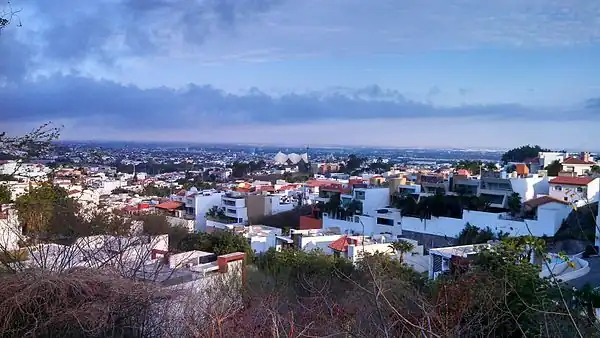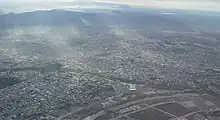| WARNING: Please see the warning in the Sinaloa article. | |
Government travel advisories
| |
| (Information last updated 06 Jan 2023) |
Culiacán (Culiacán Rosales) is a city of slightly over 1 million people (2019) in Sinaloa. Culiacán is well known for its culture, luxuries, and celebrations. Its iconic sites include its historic center, Las Riberas Park, the flag or better known as dancing fountains and religious temples such as its Basilica Cathedral, the sanctuary, and the Lomita. The modern Tres Ríos district is known for its buildings, squares, hotels, parks, restaurants, schools, etc.
Understand
| Culiacán | ||||||||||||||||||||||||||||||||||||||||||||||||||||||||||||
|---|---|---|---|---|---|---|---|---|---|---|---|---|---|---|---|---|---|---|---|---|---|---|---|---|---|---|---|---|---|---|---|---|---|---|---|---|---|---|---|---|---|---|---|---|---|---|---|---|---|---|---|---|---|---|---|---|---|---|---|---|
| Climate chart (explanation) | ||||||||||||||||||||||||||||||||||||||||||||||||||||||||||||
| ||||||||||||||||||||||||||||||||||||||||||||||||||||||||||||
| ||||||||||||||||||||||||||||||||||||||||||||||||||||||||||||
It is rarely visited by foreign tourists and is heavily underrated as a tourist destination. Almost no guide books on Mexico cover Culiacán, or if they do, they give very brief one-paragraph descriptions at most. However, Culiacán is very well-known by Mexicans for its distinct sinaloense culture.
Culiacan sits almost in the geographic center of the state of Sinaloa, about 1450 km (900 miles) south of the U.S.-Mexico border. Locals of Culiacán are known as culichis (Similarly, natives of Guadalajara are known as tapatios.).
Culiacán is famous for producing some of the best-known norteño and banda musical groups in Mexico, including Los Buitres de Culiacán, Los Bukanas de Culiacán, Larry Hernandez, Los Buchones de Culiacán.
Climate
Culiacán is dry for most of the year, except for the wet season which lasts from July to September. Summers are very hot and humid, shade temperatures can reach 45 °C (113 °F) and high humidity can produce heat indices of 50 to 55 °C (122 to 131 °F), with the risk of heavy rainfall from decaying tropical cyclones also present. Winters are much milder with less humidity and an average high of 27 °C, with warm nights.

Get in
By plane
- 🌍 Federal de Bachigualato International Airport (CUL IATA). Volaris offers five daily flights from Tijuana. A one-way ticket costs about US$85. There are also Volaris flights to Culiacán from Guadalajara and Mexico City.
By car
Mexican Federal Highway 15 (Carretera Federal 15) connects Culiacán to cities in Sonora state such as Nogales, Hermosillo, Guaymas, Ciudad Obregón, and Navojoa (from north to south), as well as Los Mochis, Guasave, Guamúchil, Mazatlán, Tepic, and Guadalajara. Toll booths and checkpoints are stationed throughout the highway.
By bus
The 🌍 Millennium International Buses Station is a major hub offering connections from various small towns around the state of Sinaloa. There are regular buses to Culiacán from Los Mochis, Mazatlán, Hermosillo, and Guadalajara.
By boat
The port of 🌍 Altata is a tourist beach town directly to the west of Culiacán. By car, it is about 50 km or 1 hour from Culiacán.
Get around
By bus
Culiacán has over 68 urban transport routes, operated by RedPlus.
The city has a few wide avenues that allow fast traffic, but the majority of streets in the city are rather narrow, and traffic jams are common. The city has a total of 9 bridges. Six cross the "Tamazula" river, two the Humaya river and the longest bridge crosses the Culiacán river of the same name as the city.
Much effort has been made to reduce traffic problems, however streets and bridges are constantly congested and it is abominable at peak times. The number of cars per capita is one of the highest in Mexico.
Taxis are plentiful in the Centro.
By car
- AGA Rent a Car, at the airport, ☏ +52 667 760 0644.
See
- Plazuela Alvaro Obregón — The city's main square, the Plazuela has many acrobats, artists, and musicians entertaining passersby.
- 🌍 Catedral Basilica de Nuestra Señora del Rosario, Av Dr. Ruperto Paliza (directly south of the Plazuela Alvaro Obregón). The city's main cathedral
- 🌍 La Lomita (Temple of Our Lady of Guadalupe). This church sits on the top of a hill directly to the south of the Zona Centro. It offers a breathtaking panoramic view of the city of Culiacán, and the sierras surrounding it. From the Plazuela Alvaro Obregón, take a bus that with a placard saying "Lomita" on its front window, and tell the bus driver to stop at La Lomita. It should take you south along Bulevar Alvaro Obregón.
- 🌍 Capilla de Jesús Malverde. This is the most well-known site in Culiacán. This chapel is dedicated to Jesús Malverde, a bandit who was executed in 1909 who has since become venerated as a folk saint by locals. Narcotraffickers and migrants alike visit this shrine to pay homage to Malverde, hoping for a successful journey up north. Malverde is often called "El Santo de los Narcotraficantes," although the chapel operators will say that he is far more than that. Plaques thanking Malverde adorn the chapel. The owner and operator of the shrine is Jesús ("Chuy") Manuel González, son of Eligio González (d. 2002), the shrine's founder. Ironically, the Palacio Estatal (State Government of Sinaloa) lies almost directly in front of the chapel, on the other side of the street. A biographical booklet on Malverde is available for M$50 (pesos).
- Malecón — Playgrounds and picnic tables abound on this beautiful and carefully maintained greenbelt which runs along the banks of the Río Tamazula.
- 🌍 Museo de Arte de Sinaloa (MASIN), Calle Gral. Rafael Buelna. This museum has many impressionist and modern abstract art pieces produced by artists from all over the state of Sinaloa. Admission M$5.
- 🌍 DIFOCUR. The cultural center of Culiacán. The complex includes various exhibits and small museums. Events take place often at DIFOCUR.
- 🌍 Ayuntamiento de Culiacán, Calle Carl. Mariano Escobedo, ☏ +52 667 715 9263. Many beautiful murals featuring street scenes in Culiacán and motifs glorifying the sinaloense spirit.
- 🌍 Parque Revolución. This park has very beautiful fountains. Just to the north of it is a newly erected statue dedicated to the 75th anniversary of XEBL (710 AM, 91.9 FM), one of Sinaloa's oldest radio stations, which has been running since 1936. Live music also plays from the statue.
- Puente Negro. This bridge is an iconic symbol of Culiacán, and is located at the confluence of the Humaya and Tamazula Rivers, which join together to form the Río Culiacán. This is comparable to the confluence of the Gombak and Klang Rivers in Kuala Lumpur, as well as the confluence of the Allegheny and Monongahela Rivers in Pittsburgh (forming the Ohio River).
- 🌍 Culiacán Zoo. — Located next to the heart of the city, forming part of the Civic Center Constitución with an extension of 13.5 hectares; which houses 1,400 animals belonging to more than 450 species including mammals, reptiles and birds.
- Culiacán Botanical Garden Located to the east of the city, this area comprises 10 ha and is home to different ecosystems and hundreds of plant and tree species. The Culiacán Botanical Garden has a variety of more than 2,000 plants.
- Presa Sanalona

- The Tres Ríos Water Park is a recreational space that was built at the confluence of the Humaya and Tamazula rivers, precisely where the Culiacán River is born. This park is very close to Parque Las Riberas. It is the largest and most visited park in the northwest of the country.
- The Dancing fountains of Culiacán are a spectacle of hundreds of independent fountains programmed to "dance" to the sound of typical Sinaloan music. This show is presented every day in an area of the 3 Ríos Project where the flagpole is located, more specifically, at the confluence of the Humaya and Tamazula rivers. The shows are always given twice at night and always at the same time.
Do
There are casinos, discos and theaters.
- Musicians, consisting of norteño, banda, and mariachi bands, can be found on Bulevar Francisco I. Madero (the Mazatlán-Culiacán highway, or the 15) between General Aquilines Serdán and Venustiano Carranza. There are Pemex gas stations at both intersections. Many musicians have rented out buildings, and some of the bandas have their own trailers. The norteño bands tend to congregate around the Madero & Carranza intersection, which is easily recognizable because of the 135-degree bend that Venustiano Carranza makes at the intersection. Norteño bands can also be found at the Mercado Garmendia playing for tips.
Learn
- Universidad Autónoma de Sinaloa (UAS)
- Instituto Tecnológico de Culiacán (ITC) http://www.itculiacan.edu.mx/
Buy
In the center are many little stores where you can buy anything. There are also malls.
- Mercado Garmendia
Eat
Budget
- Restaurant Huy Fong 匯豐餐館 (Rosales #5, Col. Centro; ☏ +52 667 715-78-17; 08:30 - 20:00) is a Chinese restaurant offering very affordable meals for around M$50 or less. It is just north of the catedral at the intersection of Alvaro Obregon (the main street that runs north-south) and General Antonio Rosales; to the left of Subway. Located in the Centro. The restaurant owners and employees are from the town of Enping in Guangdong province, China.
Mid-range
- 🌍 Restaurant China-loa, Donato Guerra 160, ☏ +52 667 712 1221. Comida China & Sushi, offers an all-you-can-eat buffet for M$90. Located in the Centro.
Splurge
Drink
Sleep
Budget
- 🌍 Hotel Sevilla, Jose Maria Morelos 170 Nte., ☏ +52 667 715 2993. Located on Morelos Street (which runs north-south) between Escobedo and Colón, in the Zona Centro. It is in the 170's block, located on the east side of the sidewalk. The lobby room has a guest computer with Internet, free of charge. Filtered water is also free. Rooms from M$300 per night.
Mid-range
- Microtel Inn & Suites. A 113-room hotel adjacent to the Modern Hospital Angels of Culiacan.
- 🌍 Hotel La Quinta Posada Real. Located near the intersection of Francisco I. Madero & Venustiano Carranza Boulevards. From M$500 per night.
Splurge
Connect
Stay safe
Downtown Culiacán is safe to walk around during the daytime and evenings (before midnight). Traveling around the outskirts ("colonias") of Culiacán at night is not recommended.
Traffic in Culiacán can be extremely aggressive, much more so than in many other parts of Mexico. Locals will attribute this to the "sinaloense" attitude, which is stereotypically aggressive, proud, and boisterous.
Culiacán (along with the town of Badiraguato) is notorious for being the birthplaces and residences of many drug lords and narcotraffickers. Mexicans from other states will often point out that Culiacán is very dangerous to visit. However, overall Culiacán is still much safer than Ciudad Juárez and many Central American cities. Most deaths occur only among drug cartels and federal armed forces.
Cope
Go next
| Routes through Culiacán |
| Los Mochis ← Pericos ← | N |
→ La Cruz → Mazatlán |